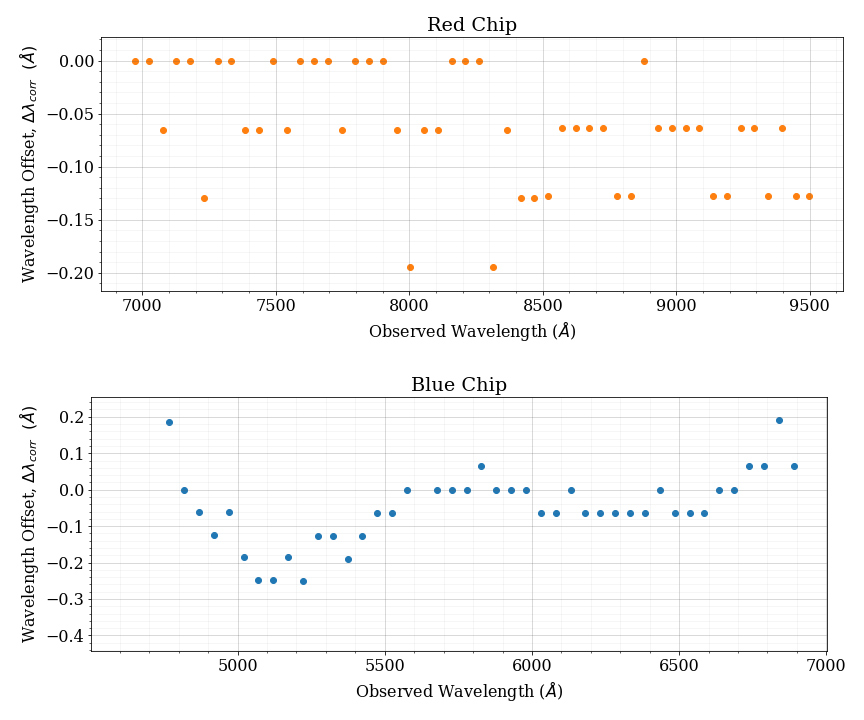DEIMOS Wavelength Calibration
Version History
Version |
Author |
Date |
|
|---|---|---|---|
1.0 |
Debora Pelliccia |
23 Feb 2021 |
1.3.2dev |
1.1 |
Kyle Westfall |
23 Mar 2023 |
1.12.2dev |
Basics
The procedure used to wavelength calibrate DEIMOS spectra follows the PypeIt general
procedure described in Wavelength Calibration. The user can choose among three Automated Algorithms
, or a By-Hand Approach, to perform the wavelength calibration. Full Template
is the preferred algorithm for DEIMOS and it is set as the default one.
Procedure
DEIMOS wavelength calibration is primarily performed by full_template().
This function requires the existence of an archived calibrated arc spectrum (i.e., template) stored in
pypeit/data/arc_lines/reid_arxiv. For DEIMOS we created, using the procedure described in
Constructing a New Wavelength Template, five templates (one per each grating) spanning a wide range of wavelengths:
keck_deimos_600ZD.fits
(~3500-10000 Å)
keck_deimos_830G.fits
(~4500-11000 Å)
keck_deimos_900ZD.fits
(~3500-10000 Å)
keck_deimos_1200G.fits
(~4200-10000 Å)
keck_deimos_1200B.fits
(~3800-7000 Å)
The Full Template algorithm performs, first, a cross-correlation between each observed arc spectrum
and the relevant archived template to obtain a rough estimate of the shift in wavelengths. The input arc spectrum
is then divided into snippets (in order to reduce non-linearities) and the cross-correlation against the template
is performed again for each snippet to get a better estimate of the shift+stretch in wavelengths, which is then
applied to the input spectrum. The wavelength solution is determined by using arc lines, detected in the input
spectrum, that match the wavelengths recorded in the Line Lists (stored as as ASCII tables
in /pypeit/data/arc_lines/lists).
Application
To wavelength calibrate DEIMOS spectra using the Full Template algorithm, the method keyword in WavelengthSolutionPar Keywords must be set to full_template and the file name of the relevant template must be specified in the reid_arxiv. These are by default set for DEIMOS.
Some of other relevant WavelengthSolutionPar Keywords are: nsnippet, sigdetect, fwhm, fwhm_fromlines.
nsnippet sets the number of snippets the arc spectrum is divided into, when the second cross-correlation is performed. The default is nsnippet=2.
sigdetect sets a threshold for the detection of the lines in the input arc spectrum. Only arc lines detected with a significance above this threshold will be used for the determination of the wavelength solution. The default is sigdetect = 5.0.
fwhm is an assumed value of the arc lines FWHM (i.e., spectral resolution) in unbinned pixels. The default for DEIMOS is fwhm = 6.0, but it may not work well if wider slits are used (slit width >1”), or for LVM slits. The keyword fwhm_fromlines should take care of this and override the assumed fwhm.
fwhm_fromlines, if set to True, allows
PypeItto compute the arc lines FWHM from the lines with the highest detection significance. The FWHM computed in this way will override the assumed fwhm, which will still be used as first guess. The default for DEIMOS is fwhm_fromlines = True.
See WavelengthSolutionPar Keywords for all the parameters that guide the wavelength calibration.
Access
Users can access the DEIMOS wavelength calibration information in a couple of ways:
Inspecting the Quality Assurance (QA) plot generated by
PypeItand saved in PNG files.Running
pypeit_chk_wavecalib Calibrations/WaveCalib_X_X_XX.fits, which prints wavelength solution information for each slit.
See WaveCalib for more information.
If the user prefers to manually wavelength calibrate, it can be done by running
pypeit_identify Arc_X_X_XX.fits Slits_X_X_XX.fits.gz. See By-Hand Approach
for more details.
Testing
Requirements state:
PD-20: “As a user, I expect automatic wavelength calibration for all slits to succeed (for narrow slits, 0.7”-2”)”
PD-21: “Use arcs to provide wavelength solutions for narrow slits (0.7” - 2”)”
PD-22: “Use special blue arcs to cover the bluest observations”
PD-37: “The pipeline produces a wavelength solution as accurate as the one derived starting from an optical model”
PypeIt meets these requirements as demonstrated by the tests performed by the PyPeIt team and described below.
Description
We performed the wavelength calibration on a large sample of 36 DEIMOS datasets spanning a wide range of wavelengths, gratings, central wavelengths, and slit widths:
Grating |
Central wavelength (slit width) |
|---|---|
600ZD |
5500 Å (1”), 6000 Å (1.5”), 6100 Å (1”), 6300 Å (1”), 6500 Å (1”), 7000 Å (0.8”), 7200 Å (1”), 7500 Å (1”), 7900 Å (1”), 8000 Å (1.2”) |
830G |
6720 Å (1”), 7500 Å (1”), 7800 Å (1”), 8100 Å (0.6”), 8100 Å (1”), 8580 Å (1”), 8580 Å (1”), 9000 Å (1”) |
900ZD |
5500 Å (0.7”), 6000 Å (1”), 8000 Å (0.75”) |
1200G |
5500 Å (1”), 6700 Å (1”), 7200 Å (1”), 7750 Å (0.7”), 8800 Å (1”) |
1200B |
5200 Å (1”), 5280 Å (1”), 5500 Å (0.85”) |
Including six datasets using LVM slitmask, which is a special slitmask composed of 5 slits with different widths (0.7”, 0.8”, 1.”, 1.2”, 1.5”). These datasets were taken with the following gratings (and central wavelengths): 830G (8400 Å), 600ZD (7100 Å), 830G (7900 Å), 1200G (7800 Å), 1200B (5450 Å), 1200B (5200 Å).
Results
Out of the 4072 slits that have been tested, for only 37 (0.9%) the wavelength calibration failed or was wrong. From a visual inspection, we found that the success of the wavelength calibration is mostly influenced by the quality of the arc spectra. In particular, artifacts, noisy spectra, ghosts, and strong emission from adjacent slits are the main responsible for failed or bad wavelength calibration. For these cases, the only way to obtain a wavelength calibration may be to perform a wavelength calibration by hand (see By-Hand Approach).
To further investigate the quality of the wavelength calibration, we inspected the distribution of the wavelength solution RMS (in pixels), reported below (left panel), and we found that the majority of the calibrated spectra have RMS<0.2 pixels.
Moreover, by comparing the wavelength calibration performed with PypeIt to the one performed with
the DEEP2 IDL-based pipeline, which produces wavelength solutions using the DEIMOS optical model, we found
very small wavelength offsets (~0.1 Å). See right panel below (dataset obtained with 600ZD grating, kindly
provided by Kevin McKinnon).

